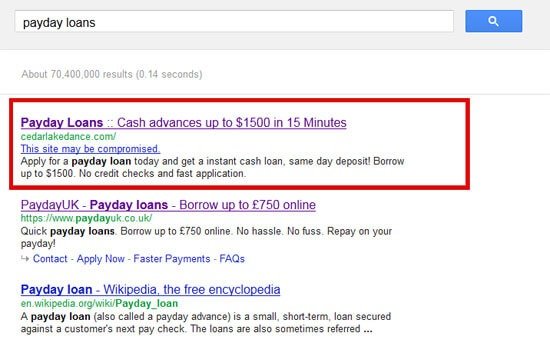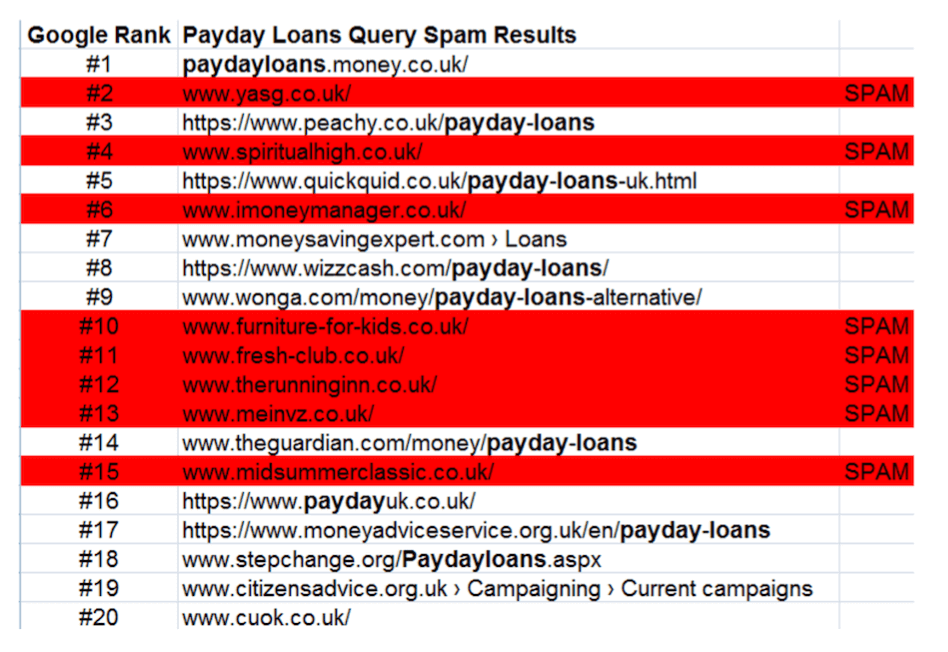When it comes to digital marketing, every consumer credit and loans business dreams of being on the first page of Google. Using pay-per-click advertising (PPC) allows you to access the top 4 spots, but at a price. The cost of a top 4 position can cost around £15 per-click and blow your budget in no-time – hence getting a spot on the free organic listings is like gold dust.
Entrepreneurs and those operating in the consumer credit industry, quickly realised that payday loans on Google was a huge revenue opportunity. In the years 2010 to 2014, the regulation in the UK was very limited, allowing new websites to crop up, take customer details and sell them on with little retribution. As a result, several hacked sites emerged to the top of Google for the term ‘payday loans’ which regularly receives over 200,000 visits a month through Google searches.
But with thousands and thousands of customers giving their details to irresponsible firms and making them open to fraud, the complaints to the authorities started to mount and Google had to react fast – releasing the payday loans algorithm for Google.
History Of The Payday Loan Algorithm
Until 2013, the first page of Google for payday loans barely featured any real payday companies, instead hacked sites with domains names included bicycle sales, women’s magazine and frankly, just random domain names. The website would be redirected once clicked to a lead generator site, usually in english, but mostly likely powered overseas.


First payday algorithm change: 2012 – Google start to clean things up
Payday Loans SEO 2.0
In early 2014, Google started to make head way and they focused on cleaning up their first page by addressing the following:
- Leveraging expired domains – and redirecting them to a website. This was used on a large scale
- Cloaking and Doorway pages – Google clamped down on those websites disguising as others or redirecting you to a totally different site once clicked.
- Using Google+ accounts – even using a Google+ account and getting loads of a followers would allow you to rank in the top few positions. Sounds crazy now, doesn’t it?
- Hacked sites – this was the big one. Any sites that seemed hacked with random domains and redirected to another site was brought down.
Read more here.
There were rumours that Google were actually selecting the order 1 to 10 manually, which is very unusual for any keyword as they usually rely on their incredible algorithm. This is just a rumour.
Payday Loans SEO 3.0
This was geared towards tackling spamming links. This refers to inbound links from any low quality sites, including reciprocal links, forums, blog networks and websites which require paid submissions in exchange for a link.
The impact of these algorithms caused huge changes overnight, with the biggest users of spammy techniques finding their websites dropping down Google by 10 pages and those with good practices either seeing a big jump or maintaining a strong position.
So How Can You Get To The Top Of Google For Payday Loans
1.Fresh Content – No need to scrape other websites or use RSS feed, just add useful content that the reader will likely find useful. You ideally want one landing page for each main keyword and do not want to combine them. Consider adding useful guides surrounding APR, debt management and budgeting to become an authority in your sector.
2. Keep Links Clean – It is better to have less links but as clean as possible. You want your links to be from reputable websites and not just as an excuse to show your boss that you got a link. Go easy on the anchor text because using ‘payday loans’ a hundred times in your links is not the way to go.
3. Be patient – Don’t expect your results to happen overnight. This is a tough algorithm to crack so keep the approach nice and clean and eventually you will be rewarded. If its dodgy, avoid it. If something doesn’t seem right or you have to question whether it will help your SEO, it is not worth the risk.
Do you have any questions about this algorithm? Get in touch at [email protected]



